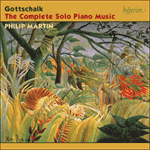
Welcome to Hyperion Records, a British classical label devoted to presenting high-quality recordings of music of all styles and from all periods from the twelfth century to the twenty-first.
Hyperion offers both CDs, and downloads in a number of formats. The site is also available in several languages.
Please use the dropdown buttons to set your preferred options, or use the checkbox to accept the defaults.

The work was originally written for four hands (RO225, New York, 1864) and was composed during a rich period of creativity when Gottschalk was living in the mountain village of Matouba in Guadaloupe during the summer of 1859. It is dedicated to the widow of the piano manufacturer Jonas Chickering (1798–1853) who had helped to save the young artist’s career during a rocky patch in 1853. In gratitude, Gottschalk switched from Pleyel and Érard (his preferred Parisian instruments) to Chickering, remaining the firm’s loyal champion for the remainder of his career.
from notes by Jeremy Nicholas © 2001
L’œuvre fut, à l’origine, composée pour quatre mains (RO225, New York, 1864) à une époque riche de créativité, alors que Gottschalk vivait dans le village de montagne de Matouba à la Guadeloupe, l’été de l’année 1859. Elle est dédiée à la veuve du facteur de pianos Jonas Chickering (1798–1853) qui aida le jeune artiste à sauver sa carrière lors de l’année difficile de 1853. En marque de gratitude, Gottschalk passera de Pleyel et Érard (ses instruments parisiens préférés) à Chickering, et restera fidèle à la marque jusqu’à la fin de sa carrière.
extrait des notes rédigées par Jeremy Nicholas © 2001
Français: Marie Luccheta
Das Werk ist ursprünglich für Klavier zu vier Händen angelegt (RO 225, New York 1864) und wurde in einer ergiebigen kreativen Phase komponiert, als Gottschalk im Sommer 1859 im Bergdorf Matouba auf Guadaloupe lebte. Es ist der Witwe des Klavierbauers Jonas Chickering (1798–1853) gewidmet, die während schwieriger Zeiten im Jahr 1853 die Karriere des jungen Künstlers retten half. Zum Dank ging Gottschalk von Pleyel und Érard (den von ihm bevorzugten Pariser Instrumenten) zu Chickering-Klavieren über und blieb bis ans Ende seines Berufslebens ein treuer Fürsprecher des Unternehmens.
aus dem Begleittext von Jeremy Nicholas © 2001
Deutsch: Anne Steeb/Bernd Müller
 Gottschalk: The Complete Solo Piano Music Gottschalk: The Complete Solo Piano MusicWith his idiomatic and graceful style, pianist Philip Martin has established himself as the foremost exponent of Gottschalk. The composer had a unique spontaneity and individuality which Martin’s performances bring vividly to the fore. The complet ...» More |

